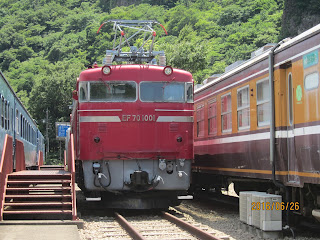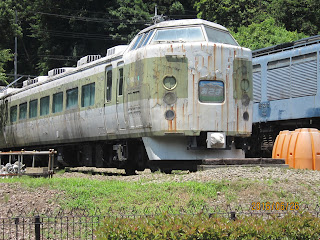This is a series 651 limited express passing the station on the Utsunomiya Line tracks.
This is that same E3 leaving the station.
This is a combination E6/E5 Komachi/Hayabusa departing, complete with camera glitch after two seconds.
Eventually, our E4 Max Toki arrived.
This is our E4 at Takasaki.
And our E4 departing Takasaki. Fun fact: with two E4 sets coupled together, this train alone can take 1600 people.
This is our 115 series EMU on the Shin'etsu main line.
Which also happens to be the location of the UPRHP.
Street running!The Usui Pass Railway Heritage Park has many exhibits, but it is mostly dedicated to their gigantic collection of EF63s that worked the former Usui Pass. The UP closed in 1997, truncating the Shin'etsu main line at Yokokawa.
This is a former Shinkansen work vehicle.
Prior to conversion to become an adhesion railway, the Usui Pass was worked by rack locomotives powered by a third rail. This is some of the original track.
Also on display were several 485 series express sets, such as this one here.
This is a EF63 on display in the covered locomotive shed.
This is another EF63.
I thought it might make a cool shot to have two EF63s framing another EF63.
This is the original EF63 that we saw earlier.
This is a work vehicle.
Attached to a ED42.
Outside, they had a DD51 on display, in the old JNR brown instead of the JR orange.
This is a snowblower...
...that was connected to a DD13 locomotive. In Hokkaido, many of these are still in service.
I think this was a KiHa 40 livestock van? It was a little hard to tell.
Inside they had pens, so...
This is some form of a KiHa that I don't know.
This is a KiHa 52 also on display.
This is a random baggage car outside.
A EF60 locomotive.
EF 13 locomotive...
A EF80.
And Japan's most famous class of steam locomotive: the D51.
The locomotives were all arranged in an outside courtyard.
This is a brown EF 63, like the one in the shed. Actually, this was the very first EF63 ever built.
This is the EF63 with another electric locomotive.
This is a EF58.
This is the same EF58 along with a EF30.
They had a passenger car that you could walk into. The first thing inside was a Western-style compartment, with sofas.
And also shoji screens.
But the rest of the train was entirely tatami!
There were two traincars, but only one of them was open to the public.
This is a EF70.
And another 485 series express train.
Another EF63.
And yet another!
The UPRHP is located in a very photogenic area. For example, this is the EF63 1 and the EF 13 with a mountain in the background.
A EF65.
On weekends the museum had little trains running for kids to ride. We went on a Monday.
They had a steam engine and a Swiss electric locomotive out in the shed for the miniature trains.
They also had some "shinkansen tunnel inspection vehicles.''
They were rubber-tired and had guide wheels.
There were two on display.
For their models in the building, they had a Narita Express (old type!)
And the Super View Odoriko in the old paint scheme.
Inside their gift shop they had a bunch of DVDs that were really cheap. Too bad our DVD player can't play Japanese dvds.
This is the 107 series EMU that took us back to Takasaki Station.
We had to wait a while before any train was empty enough for us to ride. This is a Yamabiko coming in.
This is a E4 Max Tanigawa rushing past.
Finally, our E7 Kagayaki came.
We got off at Ueno, and caught a Keihin-Tohoku Line train to Nippori. At Nippori we saw a Nippori-Toneri Liner.
But our real motive for coming to Nippori was for the railfan bridge.
Overlooking two Yamanote Line tracks, two Keihin-Tohoku Line tracks, two tracks for the Tohoku, Joetsu, and Hokuriku shinkansen, four for any rapids, freight trains, and specials, two for the Joban line, and an upper and lower deck of the Keisei mainline.
If it doesn't work, you can find it here.
Next post will be about visiting Yamagata on the Yamagata shinkansen.
























































No comments:
Post a Comment